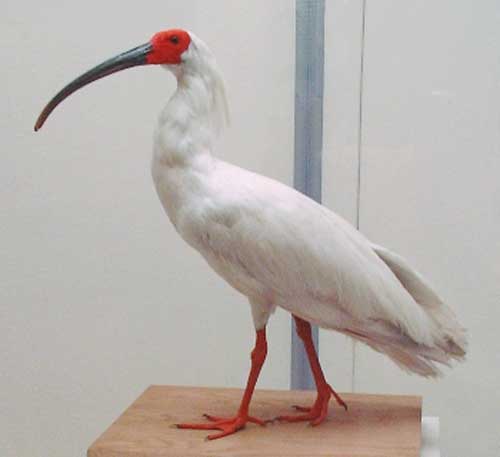Nipponia nippon Cladus: Eukaryota Name Nipponia nippon (Temminck, 1835) References * Nouveau recueil de planches coloriées d'oiseaux livr.93 pl.551
The Crested Ibis (Nipponia nippon), also known as the Japanese Crested Ibis or Toki (Japanese: トキ, variously written in kanji as 朱鷺, 鴇, 鵇 or 鴾), is a large (up to 78.5 cm long), white-plumaged ibis of pine forests. Its head is partially bare, showing red skin, and it has a dense crest of white plumes on the nape. This species is the only member of the genus Nipponia. Their habitat is usually mainlands[clarification needed] and wetlands. They make their nests at the tops of trees on hills usually overlooking their habitat. Crested Ibises usually eat frogs, small fishes, and small animals. At one time, the Crested Ibis was widespread in Japan, China, Korea, Taiwan and Russia. It has now disappeared from most of its former range. The last wild Japanese Crested Ibis died in October 2003, while the remaining wild population can be found only in Shaanxi province of China. This is not the first time this has happened, though. They were thought to be extinct through the 1960s and 1970s, until 1981 when seven ibises were found in Shaanxi, China. Extensive captive breeding programs have been developed by Japan and China to conserve the species. They were put on the State Protection List in China, which also spread throughout most of Asia.[clarification needed] Also, for the past 23 years, China has bred and protected the species. In 2002, there was a total of 130 colonies in China. Northwest Shaanxi province's research center has a history of 26 Crested Ibis fledglings including artificial, and natural incubation. On July 31, 2002, five out of seven Crested Ibis chicks hatched at an incubation center in northwest Shaanxi province. This was one of the latest records and highest record ever recorded of chicks that hatched. The parents of the chicks were chosen from 60 ibis pairs raised in that research center. Due to ongoing habitat loss, small population size, limited range, winter starvation and persecution in last century brought this endangered species to the brink of extinction. The Crested Ibis has been listed in Appendix I of CITES. On September 25, 2008, the Sado Japanese Crested Ibis Preservation Center released 10 of the birds as part of its Crested Ibis restoration program, which aims to introduce 60 ibises into the wild by 2015. This marks the first time the rare bird has returned to the Japanese wild since 1981.[1]
* BirdLife International (2008). Nipponia nippon. In: IUCN 2008. IUCN Red List of Threatened Species. Downloaded on 05 November 2008. Database entry includes justification for why this species is endangered 1. ^ http://www.iht.com/articles/ap/2008/09/25/asia/AS-Japan-Wild-Ibises.php Source: Wikipedia, Wikispecies: All text is available under the terms of the GNU Free Documentation License |
|

